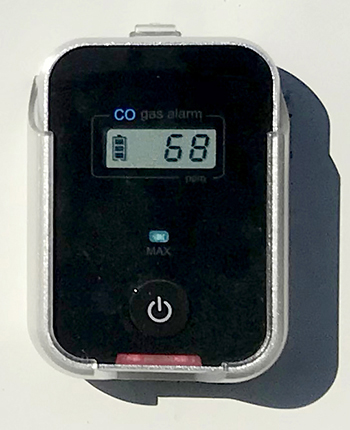Subscriber question:
"We just put a carbon monoxide detector in our airplane—and it goes off on almost every landing. Our mechanic can't find any heater leaks. Do we have a problem or should we just ignore the beeping on landing?" — Jesse D.
Jeff:
 “This is more common than you might imagine. But before I address your situation with nuisance alarms, let me say three things:
“This is more common than you might imagine. But before I address your situation with nuisance alarms, let me say three things:
First: If you ever get a carbon monoxide (CO) alarm out of the blue and you don’t know why, turn off any heat, land, get some fresh air, and check out the problem. You did the right thing by having your mechanic check for leaks in your exhaust system.
Second: There’s a bunch of conflicting data out there about an ‘acceptable’ level of CO. Err on the conservative side. Altitude already reduces oxygen availability in your lungs and flying demands more mental acuity than watching TV.
Third: The impact of CO is cumulative. While even a low level can add up over a multi-hour flight, a brief spike during landing is unlikely to cause problems.
So … what’s happening with your airplane?
Airflow over the fuselage changes with airspeed and configuration, and more exhaust gas might enter the cabin in certain situations. High power and low airspeed (high angle of attack), such as during slow flight, is a common cause. It can happen during landing, too. Don’t panic. Your airplane has probably had this CO situation the entire time you’ve owned it. You just didn’t know until installing the detector. Transient CO spikes aren’t that hazardous because you don’t stay in that condition long enough.
That said, ignoring an alarm is never a good policy, in my opinion. Some consumer CO detectors alert as low as 35 parts per million (ppm) of CO. For some airplanes—yours included—that’s low enough to trip during normal flight operations. If you can, try a higher threshold for the alarm—but no higher than 70 ppm. The Consumer Product Safety Commission, and others, use that number as a threshold for noticeable effects on the general population. Ideally, you won’t have to go even that high. If you’re still getting alerts at 70 ppm every time you land, you should investigate further.
I’m also assuming the CO level drops to zero (or near zero) during other phases of flight. If you’re seeing even 20 ppm in cruise flight, it’s worth digging deeper. If the CO level is independent of the aircraft heat being on or off, there could be cracks in the exhaust system outside of the heater shroud, deteriorated seals where items pass through the firewall, or even excessive gaps around the cabin doors.
Finally, consider a CO level over 100 ppm in an airplane an urgent situation. Land as soon as practical. If you need priority to reach the ground sooner, declare an emergency to do so. CO poisoning is insidious: The longer you’re exposed, the worse it gets, and the worse your facilities become to deal with it.”
Do you have a CO detector in your airplane?

